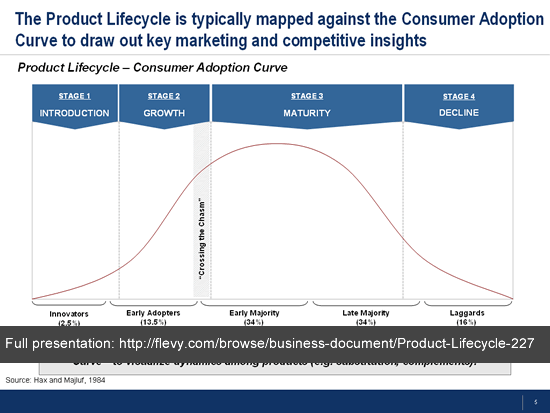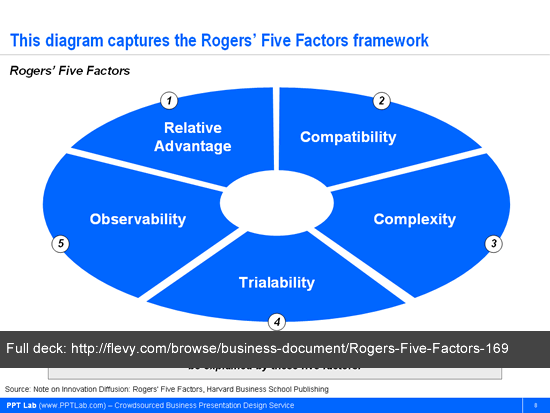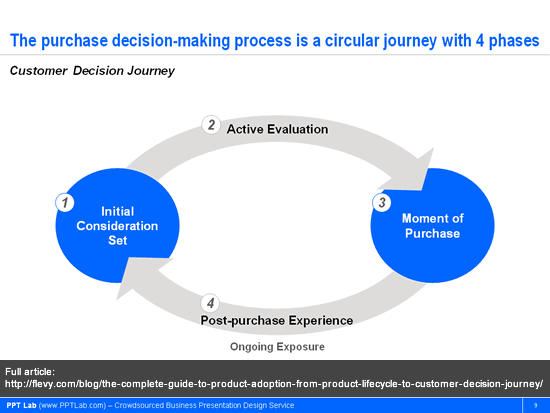Product Adoption is a compelling and important topic. It affects every single business.
There are numerous whitepapers, frameworks, and discussions focused on Product Adoption. They discuss various elements, from market conditions to product attributes to tactical engagement. The purpose of this article isn’t to present anything new. Rather, it’s an attempt to synthesize various established frameworks from reputable strategists and businesses to present a comprehensive, holistic look at Product Adoption.
Let’s start at the highest level–the market.
1. Select the Right Market Segment
At the macro level, we have market forces at play. This concept is captured best by the Product Life Cycle. The essence of this framework is that a product will go through 4 stages of development from creation to obsolescence.
The Product Life Cycle is often mapped against the Consumer Adoption Curve (one of the best known marketing frameworks). By doing this, we can determine the ideal market segment to go after at each stage of the product’s lifecycle.
To use this framework, we need to determine two things:
- What stage in the Product Life Cycle we are in.
- What segment on the Consumer Adoption Curve to go after.
Each stage of the Product Life Cycle is typified with a unique set of characteristics. Likewise, different strategies are best suited for the different stages. They are as follows:
- Introduction. In the initial stage, pricing is critical. We need to address the key question that drives Pricing Strategy: do we want to penetrate or to skim the market? Penetrating the market implies stronger consumer adoption, but at the trade off of higher margins and possibly profits.
- Growth. In this stage, the focus shifts to Customer Satisfaction, so that we can build customer loyalty and drive repeat purchases. As portrayed in the diagram above, we are now at the brink of breaching the Early Majority market.
- Maturity. Depending on the competitive dynamics in the industry, companies will elect to employ one of three strategies: Maintain, Defend, or Innovate.
- Decline. In the final stage of the product’s lifecycle, we need to make the decision to focus on innovation or make a calculated exit.
By knowing what phase of the lifecycle we are in, we have identified the general corporate strategy. We can now also identify the prevailing customer group, as defined by the Consumer Adoption Curve. There are five distinct customer groups, each characterized by a set of beliefs, motivations, and behaviors:
- Innovators. Innovators are the first to adopt a new product. They are willing to take risks, youngest in age, have the highest social class, have great financial liquidity, are very social and have closest contact to influential sources and interaction with other innovators.
- Early Adopters. This is the second fastest category of individuals who adopt an innovation. Early Adopters have the highest degree of opinion leadership among the other adopter categories. They are typically younger in age, have a higher social status, have more financial lucidity, advanced education, and are more socially forward than late adopters.
- Early Majority. Individuals in this category adopt our product after a varying degree of time. This time of adoption is significantly longer than the Innovators and Early Adopters. Early Majority tend to be slower in the adoption process, have above average social status, have contact with Early Adopters, and seldom hold positions of opinion leadership or influence.
- Late Majority. Late Majority folks will adopt an innovation after the average member of society. They approach a new product with a high degree of skepticism and only after the majority of society has adopted the product already. They are also typically skeptical about an innovation, have below average social status, very little financial lucidity, in contact with others in late majority and early majority, very little opinion leadership.
- Laggards. These guys are the last to adopt. These individuals typically have an aversion to change and tend to be advanced in age. Laggards typically tend to be focused on “traditions,” likely to have lowest social status, lowest financial fluidity, be oldest of all other adopters, in contact with only family and close friends.
Please note the customer group percentages displayed in the image above (e.g. 2.5% for Innovators) are merely illustrative. These percentages are only accurate in the case of a normal distribution and thus do not apply to all situations.
Thorough Product Life Cycle analysis provides us with the backbone to our overall product marketing strategy.
The drawback of Product Life Cycle is that it is only a market-focused framework. It doesn’t address other critical drivers to adoption, such as the Product itself and Consumer Psychology.
You may have your overarching marking mix right, but if you fail at the tactical and execution level, your product will fail.
2. Architect the Right Product
What product attributes drive rapid market diffusion and consumer adoption? Tough question.
But, good thing we have the Rogers’ Five Factors framework. Credit goes to Everett Rogers, who also created the Consumer Adoption Curve.
Rogers’ Five Factors proposes there are 5 product-based factors that drive adoption.
- Relative Advantage. This is the degree to which our new product is better than the incumbent. This advantage can be non-economic (e.g. social status, prestige). The greater the relative advantage, the faster the adoption.
- Compatibility. This factor accounts for the degree to which our product is consistent with the customers’ existing values and experiences. The greater the compatibility, the faster the adoption.
- Complexity. This is the degree to which our product is difficult to understand and use. The primary way to overcome complexity is education, but it is important to assess how willing the customer is to be educated. The greater the complexity, the slower the adoption.
- Trialability. This factor measures the degree to which our product can be experimented with on a limited basis. This factor is most important when our product is in the early stage of its lifecycle–when uncertainty about the product’s benefits are at its highest. The greater the trialability, the faster the adoption.
- Observability. This is the degree to which potential customers can see others using our product. For instance, highly observable products include cars and cell phones. Difficult to observe products include medicines and home appliances. Many companies leverage social media marketing–and specifically target “influencers”–to increase their observability factor. The greater the observability, the faster the adoption.
Let’s walk through an example of this analysis. Look at the telephone. Every home has a phone. It’s something we take for granted, something that’s necessary part of our daily lives, something we can’t imagine living without. One would assume it was adopted very quickly. Yet, the reality proves otherwise…
The telephone was invented by Alexander Graham Bell in 1876. By 1900, 25 years later, it would only be found in 10% of the households in the US. By 1935, 60 years after its invention, it could only be found in 30% of households. In fact, it wasn’t until the 1980s that the telephone reached 90% of US households.
Why was the adoption rate so exceedingly slow for this wonderful, useful invention?
A look at the Five Factors sheds some light. The Relative Advantage for the phone was low when it was introduced. It was expensive–both installation and ongoing fees were high–and you had few people you could call. It was also highly incompatible with the norms of the time. The idea of speaking into a metal box was foreign and frightening. The technology used in the phone was incredibly Complex and difficult to understand. People wondered, can it transmit diseases? Can I get electrocuted? Does it only speak English? Trialability was low–only the very wealthy and businesses had telephones installed. In fact, in its early years, the only factor the telephone had going for it was Observability, since people could the telephone wire running into a house.
3. Understand the Customer
If you are targeting the right market with the right marketing mix, have a compelling product that fosters adoption, the third essential element to analyze is the customer. What makes the customer tick? Rogers’ Five Factors touched a bit on this already, but let us take a deeper look into Consumer Psychology.
In my last article (Why People Won’t Buy Your Product Even Though It’s Awesome), we discussed three key principles of behavioral economics that drive consumer adoption:
- Losses Loom Larger than Gains
- Reference Points Matter
- The Endowment Effect
You can read that discussion here.
4. Complete the Customer Journey
In most cases, the product you’re selling is not an impulse purchase. The path to purchase is a long process–it’s a journey that can take from several days to several months. This journey is captured in a framework developed by McKinsey & Co called the Customer Decision Journey.
The Customer Decision Journey proposes that the customer goes through four phases in a cyclical process. Each phase represents a potential marketing battleground where companies compete for the customer’s purchase and loyalty.
These phases along the customer’s journey are:
- Initial Consideration. When the customer first conceives the notion of buying a product, she will develop an initial set of brands to consider buying. Brands in the initial-consideration set are three times more likely to be purchased than brands that aren’t in it. This means that Brand Awareness is vital. In this phase, we should focus on push marketing.
- Active Evaluation. In the evaluation phase, the customer is seeking information and shopping around to make an informed purchase decision. She will ask for recommendations from friends and family, read reviews online, go to the store to test out products, and so forth. This phase empowers both the customer and the company. How are companies empowered? Companies have the opportunity to enter the consideration set–and even force out companies in the Initial Consideration Set. Big brands can no longer take their position for granted. With increased online and social presences, companies are increasing the number of touch points with the customer–thus increasing their influence over the customer’s purchase decision in the Active Evaluation phase.
- Moment of Purchase. This is the point in the time when the customer goes to the retailer and makes the purchase. Even at stage of the journey, companies can still influence the purchase. This is done through in-store marketing and influence of store salesmen.
- Post-purchase Experience. After the purchase, the customer builds expectations based on her experience that will impact her next purchase journey. This creates the circular nature of the journey. In this phase, our goal is to foster customer loyalty, which will drive repeat purchases and word-of-mouth marketing. Likewise, if the customer is dissatisfied with the purchase, she will become a negative influence on the purchase decisions of others. This is not limited to her immediate circle of friends and family either. For instance, she can post a negative review on a prominent website, which will be read by countless potential customers in the Active Evaluation stage.
If our goal is to reach an emerging market, there are certain nuances that should be highlighted and understood. Though the overarching process is the same, the emphasis in marketing is different when comparing a customer in an emerging market versus a customer in an established market. For instance, in an established market, customers often rely on online reviews when making purchase decisions. In emerging markets, online sites are not yet trusted by the customer. Learn more about this topic in this article: Craft a Successful Strategy for Emerging Markets.
5. Maximize the Online Experience
The Internet is becoming more and more crucial in the Customer’s Decision Journey. Because of the Internet, the number of customer touch points has increased significantly.
In the online experience, there are 5 categories of customer touch points. They have varying levels of importance along the path to purchase:
- Paid. This category includes paid display and search advertising.
- Social. This category refers to interactions with the customer though social media (namely, Facebook, Twitter, LinkedIn, and Youtube).
- Email. Email marketing typically takes the form of recurring newsletters. Newsletters are essentially the online form of offline store circular.
- Referral. This category refers to external websites that “refer” customers to your website.
- Direct. This refers to your own website. It encompasses the customers who go directly to your website.
Here is the typical flow of online interaction with the customer through her journey. At the start, the goal is to create Brand Awareness. This is typically achieved through investments in paid advertisements. As the customer begins to actively evaluate her various product choices, Social and Email begin to play a more important role. Through social media, companies can directly engage and influence customers. Email marketing is an effective method of building rapport with a customer. Once a customer has subscribed to our newsletter, we can send regular newsletters to constantly remind her of our company and products. The customers that are most likely to make a purchase are Referral and Direct visitors. Afterwards, in the post-purchase phase, Social and Email continue to play important roles in nurturing that customer bond.
Of course, the relationship between the touch point and decision journey varies by industry and varies by geography. Google created a useful tool that captures these differences: Customer Journey to Online Purchase.
In summary, Product Adoption is driven by a number of factors. We need to…
- Select the Right Market Segment;
- Architect the Right Product;
- Understand the Customer;
- Complete the Customer Journey; and
- Maximize the Online Experience.
Proper analysis involves both strategic and tactical planning–and ties all efforts and thinking together. As Sun Tzu proclaimed:
Strategy without tactics is the slowest route to victory. Tactics without strategy is the noise before defeat.
Interested in business strategy? Check out Flevy’s collection of business frameworks and end-to-end business toolkits, most created by former consultants of top tier consulting firms.
This article only presents high level takeaways from the business frameworks referenced. For a more in-depth discussion, I recommend checking out the following:
- Product Life Cycle (PowerPoint presentation)
- Rogers’ Five Factors (PowerPoint presentation)
- Psychology of Product Adoption (PowerPoint presentation)
- Pricing Strategy (PowerPoint presentation with Excel model)
- Value-based Pricing Strategy (PowerPoint presentation)
- Consumer Decision Journey (McKinsey article)














0 comments:
Post a Comment